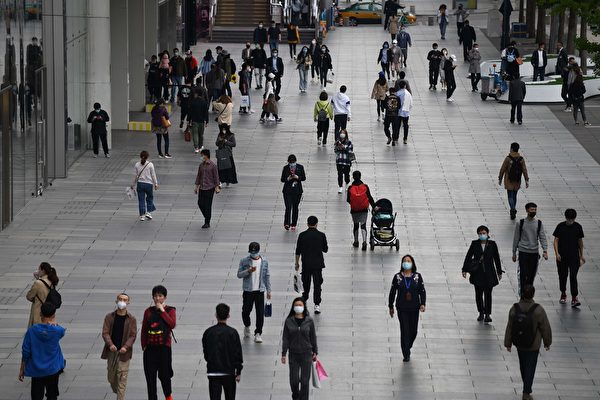In recent years’ efforts to stimulate domestic demand, the Chinese Communist Party (CCP) has been promoting a large-scale “Trade-in Program” for consumer goods since last year. However, in recent times, it has been reported in multiple regions that due to the depletion of subsidies, the “Trade-in Program” for mobile phones and household appliances has been successively halted. This setback in CCP’s policy has drawn attention.
During the promotion of the “618 Shopping Festival” on Chinese e-commerce platforms, negative news emerged. Authorities in multiple regions have halted the “Trade-in Program.” Social media posts have surfaced, with netizens claiming that Chongqing’s household appliance subsidies have been taken offline since June 4, making it the first region in the country to deplete its subsidy funds.
On June 5, a report by The Paper said that when their reporter called the Chongqing Municipal Commercial Commission on June 6, the staff member who answered the phone confirmed the suspension, stating that they would have to wait for further documents and policies to know more. The reporter also contacted Chongqing’s trade-in hotline, where officials confirmed the suspension of the “Trade-in Program” for household appliances in Chongqing, citing the exhaustion of previous subsidy funds totaling around 1.2 billion yuan.
Additionally, on June 6, Jingdong’s page for qualifying for subsidies for Jiangsu Province displayed that it was no longer possible to receive subsidies for household appliances and digital devices. The page indicated, “Activity under upgrade, unable to receive/use national subsidy benefits during the upgrading period, subsequent opening time will be notified separately.” Taobao’s “Trade-in Program” section showed that the Jiangsu subsidy was under upgrade, and during the upgrade period, users would be unable to receive/use the subsidy benefits with the reopening time to be notified later.
On June 5, a staff member from the Department of Market Operation and Consumer Promotion of the Jiangsu Provincial Department of Commerce informed mainland media that starting from June 1, Jiangsu would implement quota management online and offline for the “Trade-in Program,” which would continue until the end of the year.
Moreover, mainland netizens have been reflecting on social media platforms that the “Trade-in Program” is set to be taken offline in various regions such as Sichuan, Henan, Zhejiang, and Guangdong, with only a few projects still having the subsidy available in some parts. The smart home “Trade-in Program” in Hubei is temporarily unusable due to “activity upgrading.”
In fact, online information from mainland China shows that some regions had earlier announced the suspension of the “Trade-in Program” for consumer goods, such as: Suzhou, Gansu: Starting from 12:00 a.m. on May 10, 2025, the consumer goods trade-in subsidy was suspended; Zhenjiang and Yangzhou, Jiangsu: Starting from May 12, 2025, the home furnishing subsidy was suspended; Yingkou City, Liaoning Province: On May 12, 2025, the household appliance subsidy was suspended. These regions have halted the trade-in subsidy activities primarily due to the exhaustion of subsidy funds.
Critics have questioned that the suspension of the “Trade-in Program” indicates that local governments are no longer able to subsidize consumption.
In recent years, financial crises in local CCP governments have been escalating. Mainland social media is flooded with complaints from civil servants and teachers in various regions, including Beijing, Guangdong, and economically developed areas like Jiangsu and Zhejiang, who have been unpaid.
The CCP initiated the consumer goods trade-in and equipment upgrade projects in March 2024, mainly driven by local governments, but the results have been minimal. Starting from August, the Ministry of Finance of the CCP allocated approximately 150 billion yuan from special national bonds for the trade-in of household appliances, cars, electric bicycles, and other products.
Earlier this year, the CCP officially announced that the types of home appliances eligible for the “Trade-in Program” had increased from 8 categories in the previous year to 12 categories, including new items such as microwave ovens, water purifiers, dishwashers, and rice cookers. Consumers purchasing new energy vehicles and petrol cars with a displacement of 2.0 liters and below can receive subsidies of 20,000 yuan and 15,000 yuan, respectively. Consumer electronics products such as mobile phones and tablets priced below 6,000 yuan are eligible for a 15% subsidy.
The “Trade-in Program” is akin to borrowing from Peter to pay Paul. Early consumption of durable goods this year will reduce expectations of future expenditure on such goods in the coming years.
Many consumers have disclosed on social media that after the introduction of the “Trade-in Program” subsidy policy in 2024, prices of products on e-commerce platforms and physical stores suddenly increased. The post-subsidy prices were not significantly different from pre-subsidy prices, and in some cases, they were even higher. Businesses took advantage of the subsidies, resulting in more severe cases of “scamming” and “trapping” consumers.
Financial commentator Xiao Yi wrote in an article for Dajiyuan in April this year, stating that the fundamental issue of the Chinese economy is the imbalance between supply and demand. Oversupply stems from an investment-driven growth model, where industrial policies have long subsidized enterprises to stimulate supply expansion. On the other hand, inadequate demand results from imbalanced income distribution, with too much income concentrated in the hands of the government and state-owned enterprises, leading to insufficient personal income and a decline in household purchasing power. To address this contradiction, reducing government subsidies to industries and increasing the proportion of personal income to stimulate domestic demand should be prioritized. However, the authorities are moving in the opposite direction. They announced an increase in the “Trade-in Program” subsidy scale from 1,500 billion yuan in 2024 to 3,000 billion yuan this year. Despite the grand slogans, the actual effect is meager. At the same time, the diminishing marginal returns of this policy are becoming increasingly noticeable, and there is a lack of follow-up strength.

